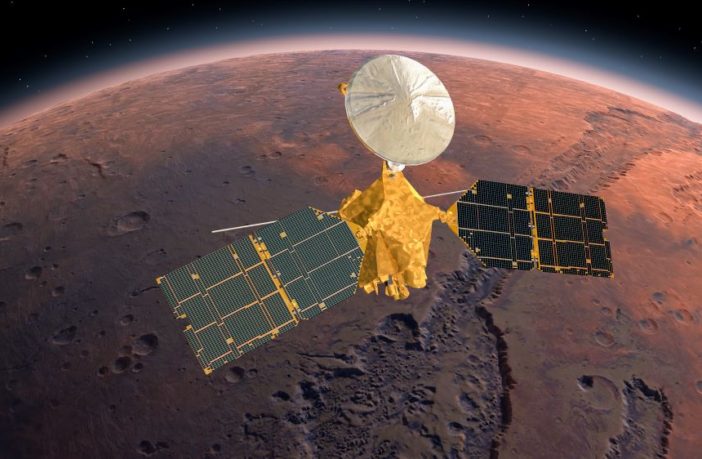An international team of researchers have observed the transport of water vapour high up into the atmosphere of the Red Planet, providing another clue in answering the mystery of when Mars might have been habitable for life.
New findings from the ExoMars Trace Gas Orbiter (TGO), a joint mission between the European Space Agency (ESA) and Roscosmos, provides insight into past and present-day water reservoirs on Mars and how seasonal changes and surface-atmosphere interactions altered the climate.
Liquid water was thought to have flowed across the surface of Mars as evidenced in the numerous examples of ancient dried out valleys and river channels. Today, it is mostly locked up in the ice caps and buried underground. However, Mars is still leaking water, in the form of hydrogen escaping from the atmosphere.
The evolution of Mars
To understand the evolution of the climate on Mars, a research team, including Open University scientists and co-authors of the paper Dr Manish Patel and Dr James Holmes, conducted a study of water vapour and ‘semi-heavy’ water (where one hydrogen atom is replaced by a deuterium atom, a form of hydrogen with an additional neutron).
Using the NOMAD (Nadir and Occultation for Mars Discovery) instrument on board TGO, researchers measured the light passing through the atmosphere of Mars to determine the presence of water vapour, and the ‘heavy’ version of water vapour, over the course of a year.
Dr Manish Patel, co-principal investigator of NOMAD and senior lecturer in planetary sciences at The Open University, said:
“The NOMAD instrument is fundamentally changing our understanding of the evolution of water on Mars. This fantastic instrument is giving us a never-before-seen view of water isotopes in the atmosphere of Mars as a function of both time and location. Measuring water isotopes is a crucial element of understanding how Mars as a planet has lost its water over time, and therefore how the habitability of the planet has changed throughout its history.”
Geronimo Villanueva of NASA’s Goddard Space Flight Center, comments:
“The deuterium to hydrogen ratio, D/H, is our chronometer – a powerful metric that tells us about the history of water on Mars, and how water loss evolved over time. Thanks to the ExoMars Trace Gas Orbiter, we can now better understand and calibrate this chronometer and test for potential new reservoirs of water on Mars.”
Sue Horne, head of space exploration at the UK Space Agency, said:
“This research is a key component in our quest to unearth the mysteries of the Red Planet. Understanding water vapour on Mars would help answer the all-important question, was there life on Mars?
“UK scientists and technology are playing a leading part in NASA’s Perseverance rover mission, due to land on Mars this month. The mission will collect samples from the planet’s surface to further our understanding of our neighbouring world.”
Water loss on Mars
The new measurements reveal dramatic variability in D/H with altitude and season as the water rises from its original location.
“Interestingly, the data shows that once water is fully vapourised, it mostly displays a common large enrichment in semi-heavy water, and a D/H ratio six times greater than Earth’s across all reservoirs on Mars, confirming that large amounts of water have been lost over time,” says Giuliano Liuzzi of American University and NASA’s Goddard Space Flight Center.
ExoMars data collected between April 2018 and April 2019 also showed three instances that accelerated water loss from the atmosphere: the global dust storm of 2018, a short but intense regional storm in January 2019, and water release from the south polar ice cap during summer months linked to seasonal change. Of particular note is a plume of rising water vapour during southern summer that would potentially inject water into the upper atmosphere on a seasonal and annual basis.
Coordinated observations with other spacecraft including NASA’s MAVEN, which focuses on the upper atmosphere, will now provide complementary insights to the evolution of water over the Martian year.
The research project received funding from the UK Space Agency. For more on the research findings, read the paper published today in Science Advances.



